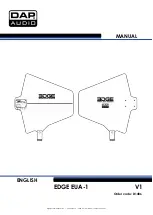
System Overview
QB.11-R Installation and Management
Quality of Service (QoS)
45
a. Protocol Destination Port Range (8000-8001, 10000-20000)
b. IP Protocol List (17 = UDP)
6. TCP
a. IP Protocol List (6)
7. UDP
a. IP Protocol List (17)
8. PPPoE Control
a. Ethertype (type 1, 0x8863)
9. PPPoE Data
a. Ethertype (type 1, 0x8864)
10.IP
a. Ethertype (type 1, 0x800)
11.ARP
a. Ethertype (type 1, 0x806)
12.Expedited Forwarding
a. IP TOS/DSCP (low=0x2D, high=0x2D, mask = 0x3F)
13.Streaming Video (IP/TV)
a. IP TOS/DSCP (low=0x0D, high=0x0D, mask = 0x3F)
14.802.1p BE
a. Ethernet Priority (low=0, high=0) (this is the equivalent of the User Priority value in the TCI (Tag Control
Information) field of a VLAN tag)
15.802.1p Voice
a. Ethernet Priority (low=6, high=6) (this is the equivalent of the User Priority value in the TCI (Tag Control
Information) field of a VLAN tag)
16.802.1p Video
a. Ethernet Priority (low=5, high=5) (this is the equivalent of the User Priority value in the TCI (Tag Control
Information) field of a VLAN tag)
17.L2 Broadcast/Multicast
a. Ethernet Destination (dest = 0x80000000, mask = 0x80000000)
Note that two different VoIP rule names have been defined for each direction of traffic, Uplink (UL) and Downlink (DL),
(index numbers 2 to 5). This has been done to distinguish the proprietary nature of the Cisco VoIP implementation as
opposed to the more standard
Session Initiation Protocol (SIP) signaling found, for example, in the Vonage-type VoIP
service.
Service Flow Class (SFC)
A Service Flow class defines a set of parameters that determines how a stream of application data that matches a certain
classification profile will be handled. The software allows to create up to 32 different SFs, including seven predefined
SFs. The software provides the ability to create, edit, and delete SFs that contain the following parameters and values:
• Service flow name
• Scheduling type – Best Effort (BE); Real-Time Polling Service (RtPS)
• Service Flow Direction – Downlink (DL: traffic from BSU to SU); Uplink (UL: traffic from SU to BSU)
• Maximum sustained data rate (or Maximum Information Rate, MIR) – specified in units of 1 Kbps from 8 Kbps up to he
maximum rate of 108000 Kbps per SU
• Minimum reserved traffic rate (or Committed Information Rate, CIR) – specified in units of 1 Kbps from 0 Kbps up to
the maximum rate of 10000 Kbps per SU















































